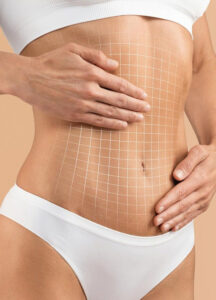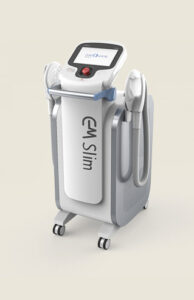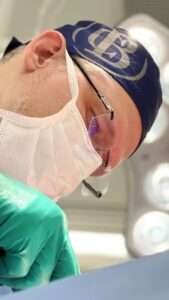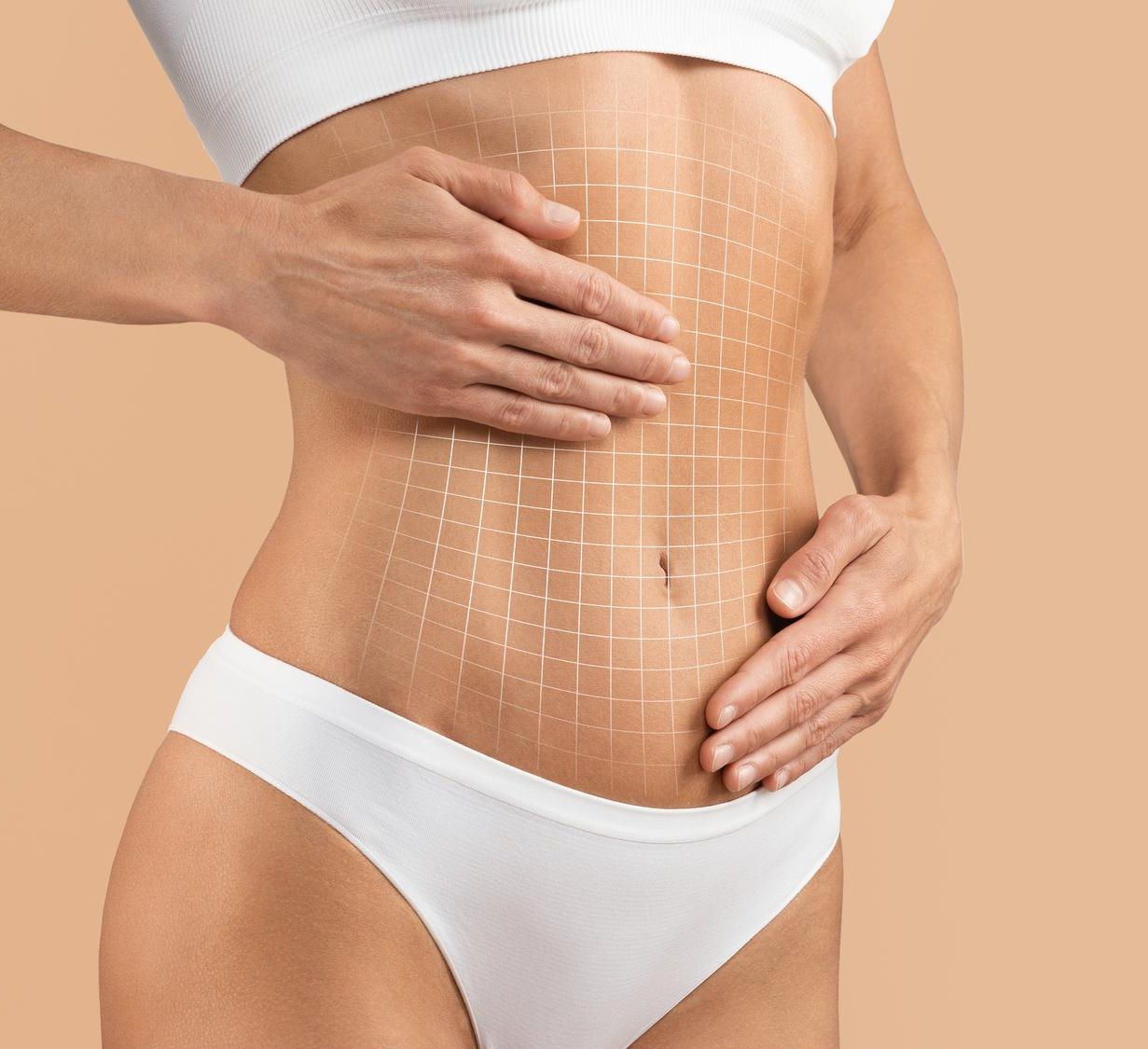

Abdominal surgery
Abdominoplasty
Abdominoplasty, also known as a tummy tuck, is a surgical procedure designed to remove excess skin and fat from the abdominal region and restore firmness to the muscles of the abdominal wall. Performed by qualified plastic surgeons, this procedure aims to give patients a more toned appearance and rejuvenated abdominal contours.
This procedure is a viable option for individuals facing challenges such as abdominal sagging after significant weight loss or after pregnancy. People in good health with excess skin and fat in the abdominal region are ideal candidates for abdominoplasty. It is generally recommended for those who have experienced substantial changes in their silhouette due to significant weight loss, pregnancy or the natural aging process.
Further information about Abdominoplasty
- Abdominal plastic surgery also involves approximating the muscles of the anterior abdominal wall (plication of the rectus abdominis) in order to reduce sagging of the abdominal wall, which can occur after pregnancies or major weight loss.
- If complications occur in the post-operative period, it may be necessary to carry out tests such as ultrasound, X-rays or CT scans of the abdomen or chest in order to elucidate the diagnosis.
- Scars evolve according to individual physiology and are generally barely noticeable, especially in the penumbra. If changes occur, there are treatments that can be used in an attempt to improve the appearance of the scars.
- It is possible that purple spots (ecchymoses), partial or total loss of sensation, temporary or permanent, may occur in the operated areas.
- Pregnancy after surgery (after one year) does not usually affect the result, but it can lead to widening of the scar and there is a greater chance of stretch marks and hernias appearing.
- Aging continues, and lack of care with weight control can mean that all the aesthetic aspect gained from the surgery is lost.
- Any need for re-operation to improve the surgery will be borne by the patient, and the surgeon will be responsible for medical fees.
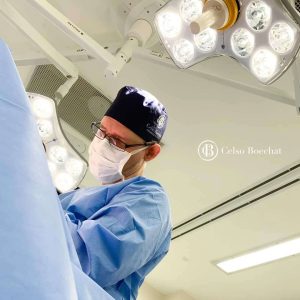

Using your fat
Fat Grafting
All the fat removed during lipo can be grafted into places that need volume, such as the buttocks, as well as imperfections, breast reconstructions and other types of repair, giving a natural and 100% rejection-free volume, according to the doctor’s and patient’s wishes, in these and other places on the body.
Preoperative Abdominoplasty (liposuction of the abdomen)
- 1. Obey the instructions given for admission
- 2. Report any abnormalities that may occur in their general condition.
- 3. Enter hospital fasting for at least 8 hours and do not bring valuables into the hospital.
- 4. Come accompanied to the hospital.
- 5. Avoid wearing earrings, rings, piercings, colored nail polish, etc. Any of these will be removed before surgery.
- 6. Avoid using medications that contain acetyl salicylic acid or salicylates in their formula (Aspirin®, AAS®, Melhoral®, some anti-inflammatory drugs). Avoid using GINKO BILOBA, ARNICA and VITAMIN E. All should be discontinued 10 days before surgery, or at the doctor's discretion. Inform the medical team if you need any medication other than the usual.
- 7. The recommended belt should be taken to the hospital.
- 8. Stop taking appetite suppressants (anorexics) 15 days before surgery.
- 9. No smoking.
Post-operative Abdominoplasty (liposuction of the abdomen)
- 1. avoid exertion for 30 days.
- 2. Avoid stretching the trunk for 30 days, unless specifically advised by the surgeon.
- 3. Get up as many times as recommended on discharge from hospital, observing the periods of sitting and avoiding maximum effort. Mobilize lower limbs.
- 4. Do not expose yourself to the sun or cold for at least 14 days.
- 5. Obey the doctor's prescription.
- 6. Return to the office for subsequent dressings, on the days and at the times stipulated.
- 7. Don't worry about the intermediate forms in the various phases. Ask your surgeon any questions you may have.
- 8. Normal diet (except in special cases). We recommend a high-protein diet (meat, eggs, milk) as well as fruit.
- 9. Wait to go on your "diet or slimming regime" once you've been cleared by your doctor. Anticipating such conduct on your own could lead to difficult consequences.
- 10. Wear the Abdominal Girdle for 24 hours a day, only taking it off to shower, for the first 30 days and for 12 hours a day for the next 30 days.
- 11. Walk bent over, with a slight flexion of the trunk, and maintain short steps, for a period of 10 to 15 days.
- 12. Sleeping on your stomach for two to three weeks
- 13. Do not wet dressings. Keep them clean and dry
- 14. If in doubt, contact your doctor.
Other body procedures
Before and After - Abdominoplasty




Surgeries and procedures performed by Dr. Celso Boechat
Other Plastic Surgeries in Rio de Janeiro
From stunning beaches to vibrant aesthetics, discover the plastic surgeries that reflect Rio de Janeiro’s beautiful spirit and dynamic aesthetic standards.
Breast surgery
Raise your self-esteem, reaffirm your beauty.
Body Surgeries
Transformations for your ideal body.
Facial surgery
Facial renewal, bring out your true expression.
All about abdominal surgery
Abdominoplasty: The most asked questions about liposuction of the abdomen
As it is a surgery that removes a certain amount of skin and fat, there will obviously be a reduction in body weight, which varies according to the volume of each patient’s abdomen. However, it is not the “kilos” removed that will define the aesthetic result, but rather the proportions that the abdomen maintains with the rest of the torso and limbs.
Most women experience some “sagging” of the abdomen after one or more childbirths, with a predominance of skin over the amount of localized fat in the area. These cases give us better results. If the patient is overweight, the result will also be compensatory and proportional to the rest of the body; however, it is worth remembering that “excess fat” in other regions neighboring the abdomen will still exist, which leads us to advise those who present themselves in this way to proceed with complementary treatment, either by liposuction or even clinical/physiotherapy, to balance the various parts between them.
Abdominal muscle diastasis (that bulge in the middle of the abdomen) is treated simultaneously with abdominal dermolipectomy (tummy tuck) surgery.
The scar resulting from a dermolipectomy is located horizontally just above the pubic hair, extending laterally to a greater or lesser extent, depending on the volume of the abdomen to be corrected. This scar is designed to be disguised under underwear, and will go through several periods of evolution, as follows:
a – IMMEDIATE PERIOD: Lasts until the 30th day and has a barely visible appearance. Some cases show a slight reaction to the stitches or dressing.
b – MEDIATE PERIOD: From the 30th day to the 12th month. During this period there will be a natural thickening of the scar, as well as a change in its color. This period is the least favorable in the healing process; as we cannot hasten the natural healing process, we recommend that patients wait, as the later period will be responsible for reducing the scarring.
c – LATE PERIOD: From the 12th to the 18th month. During this period, the scar starts to become lighter and less consistent, thus reaching its final appearance. Any assessment of the definitive result of abdominal surgery should be made after this period. Rare cases go beyond this period to achieve definitive scar maturation.
Certain patients may be prone to unsightly scarring (hypertrophic or keloid scars). This tendency should be assessed during the initial consultation, as well as your family characteristics. Fair-skinned people tend to develop this type of scar less often.
Various clinical and surgical resources allow us to improve these unsightly scars at the right time. However, this should not be confused with the natural evolution of the mediate healing period. Any doubts about your scar’s progress should be clarified during your post-operative visits, when we will have the opportunity to assess the scar’s condition. Occasionally, fluids may accumulate in the operated area, which may require puncture or even drainage, due to liquefaction of the fat or serous-bloody collections.
Various clinical and surgical resources allow us to improve these unsightly scars at the right time. However, the “mediate period” of normal healing (from the 30th day to the 12th month) should not be confused with a healing complication. Any doubts about your progress should be clarified with your doctor.
In the previous answer, some comments were made about the evolution of the scar. However, there are still a few observations to be made about the new abdomen, in terms of its consistency, sensitivity, volume, etc.
- In the first few months, the abdomen is relatively numb, as well as being subject to periods of “bloating”, which should subside spontaneously. At this stage, the abdomen may look “stretched” or “flat”.
- Over the months, once you’ve started exercising, you’ll gradually achieve the definitive result. Any result before 12 to 18 months after surgery should not be considered definitive.
Your own navel will be transplanted and, if necessary, remodeled. It should be borne in mind that around the navel there will be a scar that will undergo the same evolution as the lower scar. There are various techniques for reattaching the navel. All of them are subject to future surgical revisions, should the need arise.
Not always. This depends on your torso type (chest + abdomen). If it is of the short type, it will be partially corrected. If it’s a long one, the result will be more favorable. Also of great importance in this respect is the thickness of the panniculus adiposus (fat thickness) that lines this area of the body.
Your gynecologist will be able to advise you on the advisability of a new pregnancy. As for the outcome, you can’t predict it, it’s advisable to have the offspring already defined before the tummy tuck.
Dermolipectomies generally don’t cause severe pain and if they do occur, it can be controlled with common painkillers.
Every medical act includes a variable risk and plastic surgery as part of medicine is no exception. You can minimize the risk by preparing each patient properly, but you can’t eliminate it completely. The surgical risk is not very different from other plastic surgeries, when there are no aggravating factors and the usual surgical medical care is in place.
General or peri-dural anesthesia; even local anesthesia under sedation can be used in special cases.
As much as the case demands. However, surgical time should not be confused with the length of time the patient stays in the operating room, as this also includes the period of anesthetic preparation and post-operative recovery.
One to three days.
Yes. Special dressings, changed periodically by the medical team.
The stitches can be removed around the 7th day. day, and can be done selectively in the days that follow. Total withdrawal rarely lasts more than two weeks.
Normally, a full bath can be taken from the 7th day onwards, as long as it is assisted by another trained person. day, or after the dressings have been removed. Wait for individualized advice for your case.
It should not be forgotten that, until the desired result is achieved, several phases are characteristic of this type of surgery. So the final result depends not only on the scar’s evolution, but also on the shape of the abdomen, as well as its sensitivity, consistency, etc. Time and your body will take care of any minor inconveniences. Any concerns you may have should be passed on to your surgeon, who will provide you with the necessary additional information. A short period of emotional depression may occur in the first few weeks, due to the transitory aspect, and usually stems from the anxiety of achieving the final result as soon as possible. Remember that no abdominal surgery result can be considered definitive until at least 12 months have passed.
Possible risks of Abdominoplasty
PLASTIC SURGERY, like any other surgery, has risks and complications, some of which are specific to it and others that are generic to any type of surgery. These include:
Generic
1. Allergies: Some medications or products used during surgery can cause allergic reactions, which can even lead to death. Allergic reactions are patient-dependent and can occur either to medicines or products that the patient has never had contact with, or to those that they have had previous contact with, even if they didn’t have a previous reaction.
2. Infection: Our body is colonized by countless bacteria, with which, at first, we live in extreme harmony. However, after surgery, they can cause infection, requiring treatment with antibiotics and rarely re-operation.
3. Hematoma: Accumulation of blood in the operated area, from a vessel that was not bleeding at the end of the operation, but did so in the immediate post-operative period. It can be treated by aspiration with a syringe and needle or, rarely, re-operation may be necessary.


Book your appointment
Find out everything you need in one consultation
Possible risks of Abdominoplasty
PLASTIC SURGERIES, like any other surgery, have risks and complications, some of which are specific to them and others that are generic to any type of surgery. These include:
Generic
1. Allergies: Some medications or products used during surgery can cause allergic reactions, which can even lead to death. Allergic reactions are patient-dependent and can occur either to medicines or products that the patient has never had contact with, or to those that they have had previous contact with, even if they didn’t have a previous reaction.
2. Infection: Our body is colonized by countless bacteria, with which, at first, we live in extreme harmony. However, after surgery, they can cause infection, requiring treatment with antibiotics and rarely re-operation.
3. Hematoma: Accumulation of blood in the operated area, from a vessel that was not bleeding at the end of the operation, but did so in the immediate post-operative period. It can be treated by aspiration with a syringe and needle or, rarely, re-operation may be necessary.
4. Seroma: Accumulation of oily liquid resulting from the liquefaction of manipulated fatty tissue. It can’t be predicted. It can be treated by aspiration with a syringe and needle or, rarely, re-operation may be necessary.
5. Thrombosis: Any surgical procedure can lead to venous thrombosis. This can be predicted in predisposed patients, but can also occur in healthy patients without any predisposing factors.
Specific
(1) Epidermolysis: This is the loss of the superficial layer of skin around the surgical incision. It can be caused by excess tension in the surgical wound, which is very common when patients do not respect the recommended position – anterior flexion of the trunk.
2. Necrosis: This consists of the death of part of the skin, resulting in a wound that will heal slowly and must be monitored with daily dressings and, if necessary, surgical treatment. This necrosis can affect the quality of the final scar.
3. Irregularities: Due to the specific characteristics of the liposuction and tummy tuck technique, skin irregularities expressed as depressions, nodules or small excesses at the edges of the scars can occur in the immediate and late postoperative periods.
4. Perforations: Due to the characteristics of the liposuction technique, perforations of the abdominal wall can occur with or without injury to the intra-abdominal viscera, and intervention by General Surgery may be necessary to treat them, through a vertical incision in the midline of the abdomen, which will leave a scar. These are life-threatening complications and should be treated as soon as they are diagnosed.
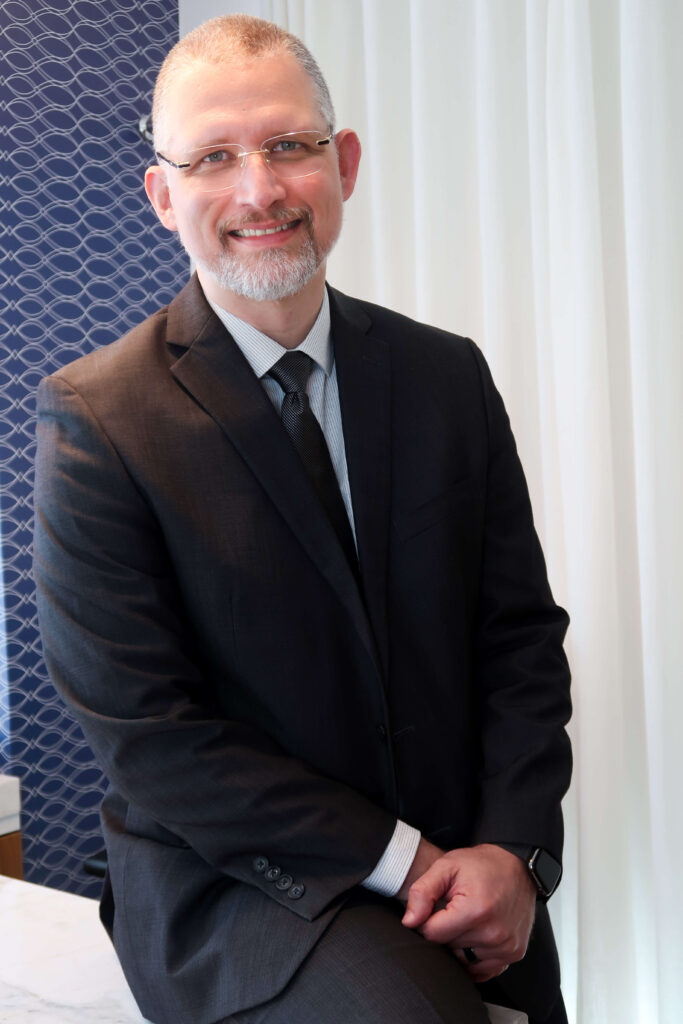

Appointment
Make an appointment and get your questions answered
Schedule an appointment with plastic surgeon Dr. Celso Boechat. Discover the path to aesthetic transformation and improved self-esteem. Our specialized team is ready to guide you through the procedure options, answering your questions and creating a personalized plan to suit your needs. Book your appointment now and take the first step towards a more confident and radiant version of yourself.
Send a message via WhatsApp
Service and consultations
Call Us
(21) 997336862
Opening hours
Monday to Friday - 09:00 - 21:00
Saturdays and Sundays - Closed, only for surgeries
